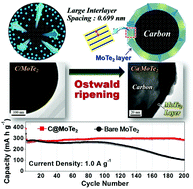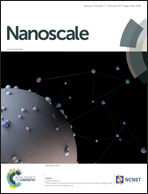Carbon/two-dimensional MoTe2 core/shell-structured microspheres as an anode material for Na-ion batteries†
Abstract
Unique-structured composite microspheres of carbon and MoTe2 were prepared by a two-step process. Precursor C–MoOx composite microspheres were prepared by spray pyrolysis, and then the precursor was transformed into C–MoTe2 composite microspheres by a tellurization process. C–MoTe2 composites with a uniform distribution of MoTe2 nanocrystals (C/MoTe2) and core–shell-structured C–MoTe2 composites (C@MoTe2) were synthesized at tellurization temperatures of 450 and 600 °C, respectively. At a higher tellurization temperature of 600 °C, all of the MoTe2 nanocrystals moved to the surface of the microsphere because of the Ostwald ripening process. The initial discharge capacities of the C/MoTe2, C@MoTe2, and bare MoTe2 (i.e., containing no carbonaceous materials) powders for Na-ion storage at a current density of 1.0 A g−1 were 328, 388, and 341 mA h g−1, respectively. The discharge capacities of the C/MoTe2, C@MoTe2, and bare MoTe2 powders for the 200th cycle were 241, 286, and 104 mA h g−1, respectively, and the corresponding capacity retentions, which were measured from the second cycle were 100%, 99%, and 37%, respectively. The high structural stability and well-developed two-dimensional layer of MoTe2 of the C@MoTe2 microspheres provide superior Na-ion storage properties compared to those of the C/MoTe2 microspheres and bare MoTe2 powder.



 Please wait while we load your content...
Please wait while we load your content...